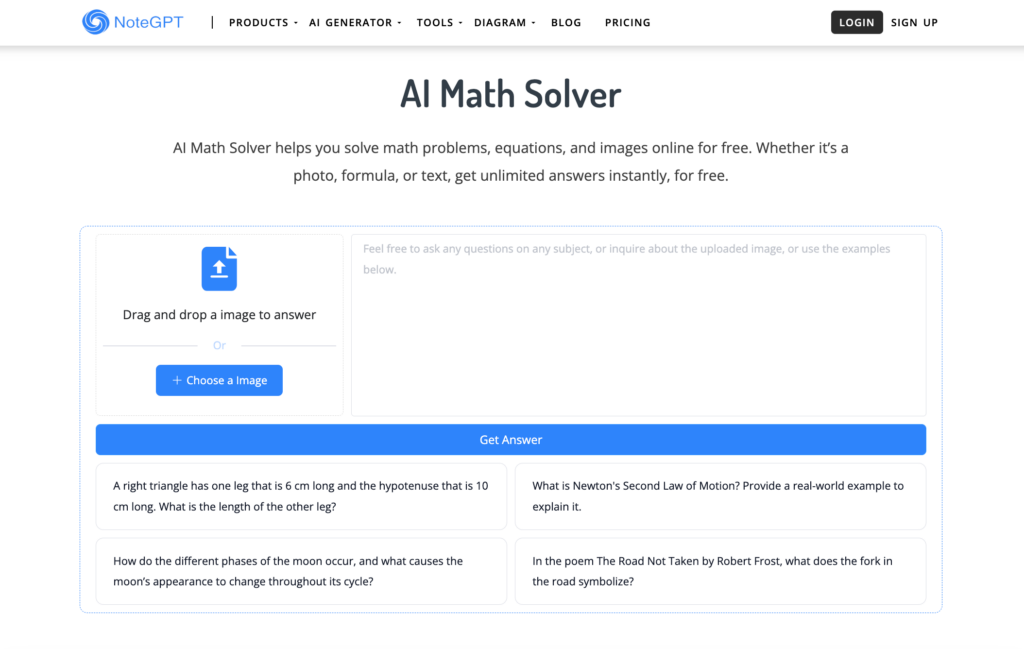Math word problems can often feel like solving riddles, requiring a clear strategy to break them down and solve effectively. One of the most effective methods for tackling math word problems is the CUBE strategy. In this article, we’ll explore the concept of CUBE, its benefits, and provide a detailed step-by-step guide on how to apply it. Additionally, we’ll introduce you to a powerful free online tool, AI Math Solver, that can enhance your problem-solving experience by providing detailed solutions to any math problem you enter or upload.
What Is the CUBE Strategy?
The CUBE strategy is a step-by-step approach designed to help students and problem-solvers systematically tackle math word problems. It stands for:
- C: Circle the numbers
- U: Underline the question
- B: Box math keywords
- E: Evaluate and eliminate unnecessary information
By following these four steps, you can organize the information in a word problem, focus on the essential details, and avoid common pitfalls.
Why Use the CUBE Strategy?
Many students struggle with math word problems because they find it hard to translate text into actionable steps. The CUBE method simplifies this process by creating a structured way to dissect problems. Here are some of its key benefits:
- Improves Focus: By circling numbers and underlining questions, you can zero in on critical information.
- Organizes Thoughts: Boxing math keywords makes it easier to identify operations and relationships.
- Reduces Mistakes: Eliminating unnecessary details ensures you don’t get distracted by irrelevant information.
- Enhances Problem-Solving Skills: CUBE helps students build analytical skills by breaking problems into manageable chunks.
Benefits of the CUBE Strategy
1. Simplifies Complex Problems
Math word problems often include extra information or challenging phrasing. The CUBE method trains you to filter out the noise and focus on what’s relevant.
2. Builds Confidence
Structured problem-solving techniques like CUBE provide a clear roadmap, reducing anxiety and boosting confidence in tackling even the most intimidating problems.
3. Encourages Attention to Detail
By requiring you to circle, underline, and box specific elements of the problem, the CUBE method ensures you don’t overlook important details.
4. Makes Learning Interactive
The physical act of marking up a problem—circling, underlining, and boxing—engages different parts of the brain, reinforcing comprehension and retention.
Step-by-Step Guide to Solving Math Word Problems Using CUBE
Step 1: Circle the Numbers
Start by scanning the word problem and circling all the numerical values mentioned. These could include:
- Whole numbers
- Fractions or decimals
- Units (e.g., “5 liters,” “10 miles”)
Example:Sarah has 3 apples, buys 7 more, and gives away 2. How many does she have left?
- Circle:
3,7,2
Step 2: Underline the Question
Next, underline the specific question being asked in the problem. This ensures you understand the goal before diving into calculations.
Example:Sarah has 3 apples, buys 7 more, and gives away 2. How many does she have left?
- Underline: How many does she have left?
Step 3: Box Math Keywords
Identify and box any keywords that provide clues about the operations required to solve the problem. Look for terms like:
- Addition: altogether, sum, in total
- Subtraction: left, fewer, difference
- Multiplication: product, times, of
- Division: per, each, split
Example:Sarah has 3 apples, buys 7 more, and gives away 2. How many does she have left?
- Box: buys (addition), gives away (subtraction)
Step 4: Evaluate and Eliminate Unnecessary Information
Finally, evaluate all the information in the problem and eliminate anything that doesn’t contribute to the solution. Sometimes, problems include extra details designed to confuse you.
Example: If the problem mentioned the type of apples Sarah bought (e.g., Granny Smith), you could ignore that detail as irrelevant.
Example: Solving a Word Problem Using CUBE
Let’s apply the CUBE strategy to a sample problem:
Problem:John travels 15 miles to work every day. Over 5 days, he also makes a 2-mile detour each day for coffee. What is the total distance he travels in a week?
- Circle the Numbers:
15,5,2 - Underline the Question: What is the total distance he travels in a week?
- Box Math Keywords: total (addition), each day (repetition)
- Evaluate:
- Daily work commute:
15 miles - Detour for coffee:
2 miles - Weekly total:
(15 + 2) × 5 = 85 miles
- Daily work commute:
Using AI Math Solver to Simplify Your Work
While the CUBE strategy is an excellent manual tool, modern technology can provide an extra edge. Enter AI Math Solver, a free online tool that simplifies math problem-solving.

What Is AI Math Solver?
AI Math Solver is an intelligent platform where you can:
- Enter your math word problems as text.
- Upload photos of handwritten or printed problems.
- Receive detailed, step-by-step solutions.
How to Use AI Math Solver
- Visit AI Math Solver.
- Choose to type in your problem or upload a photo.
- Click "Solve" and review the comprehensive solution provided by the AI.

Benefits of AI Math Solver
- Instant Answers: Get solutions in seconds.
- Step-by-Step Explanations: Understand the entire process, not just the final answer.
- Supports All Levels: Whether it’s basic arithmetic or advanced calculus, the tool can handle it.
- Accessible Anywhere: Use it on your smartphone, tablet, or computer for on-the-go problem solving.
Combining CUBE and AI Math Solver
For the best results, consider using both the CUBE strategy and AI Math Solver:
- Start with CUBE to manually analyze the problem, ensuring you grasp its structure.
- Use AI Math Solver for confirmation and deeper understanding of the solution.
This hybrid approach builds problem-solving skills while leveraging technology for accuracy and efficiency.
Conclusion
The CUBE strategy is a simple yet powerful method for solving math word problems. By circling numbers, underlining questions, boxing keywords, and evaluating details, you can systematically tackle even the trickiest problems. And when paired with tools like AI Math Solver, solving math problems becomes faster, easier, and more enjoyable.
Visit AI Math Solver today and see how it can transform your approach to math problem-solving. Don’t just solve problems—master them!

